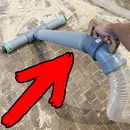Introduction: Why Insulate a Chimney?
Are you a homeowner in a cold climate? Are you using a woodstove to heat your home?
If yes, then you might want to consider insulating your chimneys! This will lower the fire hazard risk and extend the life of your chimney.
This is a short tutorial on how to insulate brick chimneys. Let's get started!
Step 1: But Why?
This is probably the question that rose in your head when you saw this ´ible.
The reason is simple. Fire used to be the main source of heat but nowadays we have more efficient and convenient solutions to heat our homes. Wood stoves are not used so much anymore which means that the chimney cools down completely. Centuries ago when home insulation was poor a fire was roaring constantly during the winter months the chimney never cooled down.
When you start heating a completely cooled down chimney the hot air will meet the cold stone and condensation water forms on the inside walls of the chimney. This leads to several problems like tar buildup and voids in mortar. As you guessed this is a fire hazard and really bad for the chimney.
After insulating the chimney will cool down so fast but the main advantage is that it will heat up faster as well, meaning that any condensation water that forms will evaporate faster and do less damage.
Step 2: What You Will Need
The most important thing you need is the insulation material. As we are dealing with fire and hot gases here we need something that can take the heat. I decided to go with mineral insulation from a company called Rockwool. The product is called Firerock and it is 25 mm thick, has aluminium foil on one side and is A1 fire class meaning it is completely non-combustible. In case of a fire, it will not burn no matter what. I chose this because it was readily available in my area. Chances are it will not be available where you live so it is a good idea to consult professionals to get some advice.
To attach the sheets I used aluminium foil tape.
Tools needed for cutting this material are:
- A sharp knife
- Straight edge
- Tape measure
Step 3: Attach the Panels
Remove anything that prevents the panels from laying flat against the chimney. Cut the panels to size and attach them to each other using aluminium foil tape. With this insulation panel, the side with foil is actually meant to go on the inside (towards the hotter surface) to radiate the heat but I chose to leave it on the outside. This allowed for an easy attaching with foil tape and it also created a windproof barrier (mineral insulation does not work if the wind is blowing through it).
It´s easier to first attach the panels to each other with small strips and then come back later to tape all the seams thoroughly.
Step 4: Finished
And that is it - the chimneys are insulated!
Please note that I am no fire expert! I am not responsible for any damage to life or property! I did consult professionals before doing this project.
If you have any questions please do not hesitate to leave them down below!
Cheers
Andu













